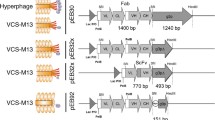Abstract
Efficient display of antibody on filamentous phage M13 coat is crucial for successful biopanning selections. We applied a directed evolution strategy to improve the oligovalent display of a poorly behaving Fab fragment fused to phage gene-3 for minor coat protein (g3p). The Fab displaying clones were enriched from a randomly mutated Fab gene library with polyclonal anti-mouse IgG antibodies. Contribution of each mutation to the improved phenotype of one selected mutant was studied. It was found out that two point mutations had significant contribution to the display efficiency of Fab clones superinfected with hyperphage. The most dramatic effect was connected to a start codon mutation, from AUG to GUG, of the PelB signal sequence preceding the heavy chain. The clone carrying this mutation, FabMGUG, displayed Fab 19-fold better and yielded twofold higher phage titers than the original Fab.







Similar content being viewed by others
References
Bradbury, A., & Marks, J. (2004). Antibodies from phage antibody libraries. Journal of Immunological Methods, 290, 29–49.
Malone, J., & Sullivan, M. (1996). Analysis of antibody selection by phage display utilizing anti-phenobarbital antibodies. Journal of Molecular Recognition, 9, 738–745.
Röthlisberger, D., Honegger, A., & Plückthun, A. (2005). Domain interactions in the Fab fragment: A comparative evaluation of the single-chain Fv and Fab format engineered with variable domains of different stability. Journal of Molecular Biology, 347, 773–789.
Kortt, A., Lah, M., Oddie, G., Gruen, C., Burns, J., Pearce, L., et al. (1997). Single-chain Fv fragments of anti-neuraminidase antibody NC10 containing five- and ten-residue linkers form dimers and with zero-residue linker a trimer. Protein Engineering, 10, 423–433.
Hust, M., & Dübel, S. (2004). Mating antibody phage display with proteomics. Trends in Biotechnology, 22, 8–14.
McCafferty, J., Griffiths, A., Winter, G., & Chiswell, D. (1990). Phage antibodies: filamentous phage displaying antibody variable domains. Nature, 348, 552–554.
Kirsch, M., Zaman, M., Meier, D., Dübel, S., & Hust, M. (2005). Parameters affecting the display of antibodies on phage. Journal of Immunological Methods, 301, 173–185.
Lee, C., Sidhu, S., & Fuh, G. (2004). Bivalent antibody phage display mimics natural immunoglobulin. Journal of Immunological Methods, 284, 119–132.
Hust, M., Jostock, T., Menzel, C., Voedisch, B., Mohr, A., Brenneis, M., et al. (2007). Single chain Fab (scFab) fragment. BMC Biotechnology, 7, 14.
Rondot, S., Koch, J., Breitling, F., & Dübel, S. (2001). A helper phage to improve single-chain antibody presentation in phage display. Nature Biotechnology, 19, 75–78.
Sambrook, J., Fritsch, E. F., & Maniatis, T. (1989). Molecular cloning a laboratory manual (2nd ed.). Cold Spring Harbor, NY: Cold Spring Harbor Laboratory.
Korpimäki, T., Brockmann, E., Kuronen, O., Saraste, M., Lamminmäki, U., & Tuomola, M. (2004). Engineering of a broad specificity antibody for simultaneous detection of 13 sulfonamides at the maximum residue level. Journal of Agriculture and Food Chemistry, 52, 40–47.
Deyev, S., Waibel, R., Lebedenko, E., Schubiger, A., & Plückthun, A. (2003). Design of multivalent complexes using the barnase*barstar module. Nature Biotechnology, 21, 1486–1492.
Jung, S., & Plückthun, A. (1997). Improving in vivo folding and stability of a single-chain Fv antibody fragment by loop grafting. Protein Engineering, 10, 959–966.
Lefranc, M., Pommié, C., Ruiz, M., Giudicelli, V., Foulquier, E., Truong, L., et al. (2003). IMGT unique numbering for immunoglobulin and T cell receptor variable domains and Ig superfamily V-like domains. Developmental and Comparative Immunology, 27, 55–77.
Lefranc, M., Pommié, C., Kaas, Q., Duprat, E., Bosc, N., Guiraudou, D., et al. (2005). IMGT unique numbering for immunoglobulin and T cell receptor constant domains and Ig superfamily C-like domains. Developmental and Comparative Immunology, 29, 185–203.
Miller, J., & Albertini, A. (1983). Effects of surrounding sequence on the suppression of nonsense codons. Journal of Molecular Biology, 164, 59–71.
Løset, G., Kristinsson, S., & Sandlie, I. (2008). Reliable titration of filamentous bacteriophages independent of pIII fusion moiety and genome size by using trypsin to restore wild-type pIII phenotype. Biotechniques 44, 551–552, 554.
Goldsmith, M., & Konigsberg, W. (1977). Adsorption protein of the bacteriophage fd: Isolation, molecular properties, and location in the virus. Biochemistry, 16, 2686–2694.
Knappik, A., & Plückthun, A. (1995). Engineered turns of a recombinant antibody improve its in vivo folding. Protein Engineering, 8, 81–89.
Kay, B. K. (1996). Phage display of peptides and proteins a laboratory manual. San Diego, CA: Academic Press.
Ewert, S., Huber, T., Honegger, A., & Plückthun, A. (2003). Biophysical properties of human antibody variable domains. Journal of Molecular Biology, 325, 531–553.
O’Donnell, S., & Janssen, G. (2001). The initiation codon affects ribosome binding and translational efficiency in Escherichia coli of cI mRNA with or without the 5′ untranslated leader. Journal of Bacteriology, 183, 1277–1283.
Clark, B., & Marcker, K. (1966). The role of N-formyl-methionyl-sRNA in protein biosynthesis. Journal of Molecular Biology, 17, 394–406.
Jestin, J., Volioti, G., & Winter, G. (2001). Improving the display of proteins on filamentous phage. Research in Microbiology, 152, 187–191.
Lin, B., Renshaw, M., Autote, K., Smith, L., Calveley, P., Bowdish, K., et al. (2008). A step-wise approach significantly enhances protein yield of a rationally-designed agonist antibody fragment in E. coli. Protein Expression and Purification, 59, 55–63.
Acknowledgment
This study was supported by the Finnish Funding Agency for Technology and Innovation (Tekes).
Author information
Authors and Affiliations
Corresponding author
Rights and permissions
About this article
Cite this article
Huovinen, T., Sanmark, H., Ylä-Pelto, J. et al. Oligovalent Fab Display on M13 Phage Improved by Directed Evolution. Mol Biotechnol 44, 221–231 (2010). https://doi.org/10.1007/s12033-009-9231-3
Published:
Issue Date:
DOI: https://doi.org/10.1007/s12033-009-9231-3




